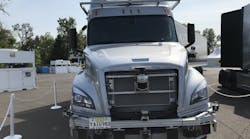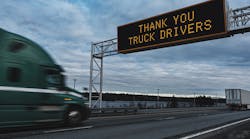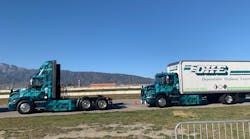Progress can sometimes be measured in the smallest of ways. An example is the evolving vocabulary accompanying advancements in “automated” driving.
Back in 2014, when Daimler AG first demonstrated the Mercedes-Benz Future Truck, executives were repeatedly saying the Highway Pilot system was not meant to replace drivers. Still, it was difficult not to describe the act of seeing a truck safely traveling on a road without an active driver as anything other than “driverless.”
That word became even more commonly used the following year after the Freightliner “Inspiration” truck debut at the Hoover Dam, and numerous other companies also began showing off their platooning and active safety system technologies.
As more and more of these demonstrations took place, there was an effort to phase out the use of “driverless.” The feeling was that unlike the Google car with no steering wheel, using “driverless” under almost any circumstance in trucking was misinterpreting what was actually taking place.
It was viewed as confusing the general public, and maybe even some politicians. Instead, I remember being urged in casual conversations with a number of executives to use “autonomous” rather than “driverless.”
That was a phrase I tried to incorporate into my coverage the past 18 months. During that time, advancements have continued at a dizzying pace, and both Congress and the U.S. Department of Transportation have taken greater interest in this area.
Within the trucking industry, there has been a robust discussion whether Level 3 of autonomous driving is safe or effective, as opposed to striving to develop a Level 4 system.
Though the main focus Daimler Truck North America’s gathering last week was the introduction of two all-electric trucks, the event included a demo of a two-truck platoon with automatic emergency braking.
That led into a discussion of about the various levels of autonomy, with Derek Rotz, DTNA's director of advanced engineering, sharing an opinion that I have heard several times recently.
He said “autonomous” is a term that should only be used when describing Level 5 – which is a full automation system able to operate on any road and in any conditions.
Everything else should be viewed as “automated,” because it will require a driver in the vehicle. That includes Level 4, sometimes considered trucking’s "holy grail" since it is likely to dramatically improve highway safety, and could pave the way for hours-of-service rule changes.
A report earlier this week by Securing America’s Future Energy (SAFE) found that by 2050 autonomous vehicle will be up to $6 trillion in benefits to the U.S. economy. That is yet another sign how this movement is not going away.
But there remain a long way to go in the areas of public approval and regulatory victories to make that happen. And along the way, words matter.
Automated trucking it is.



